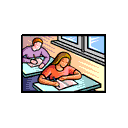—>Students' ability to "[u]se a variety of technologies to address a range of audiences."
One way we can assist our students to learn to "use" technologies is to focus on the connections between what our students are already doing (as soon as we can figure out what that may be) and more "traditional" (e.g., academic) forms, encouraging students to see—>Students' ability to "[u]nderstand the collaborative and social aspects of writing processes."
We can help students learn to enter the scholarly conversation by helping them to understand that all writing is inherently collaborative and social. That is, the knowledge bases we rely on to formulate our own so-called original ideas are predicated on the voices of others. Moreover, it is only in response to our conceptions of a reader's possible questions or reactions to our arguments that we can write at all. Technology, of course, can help to facilitate collaboration in (and beyond) the writing classroom. And yet, many of our classrooms are built to work against collaboration: our students may log in to a chat room where they talk to each other through the medium of text in online spaces which have been carefully configured so that only students in the same classroom can interact, while at the same time they sit in nice, neat rows, ensuring that the physical act of "writing" is a solitary experience, and the use of other people's words in their writing projects is strictly controlled.Every semester, our discussion lists turn again and again to the subject of plagiarism. In a recent thread on one of the listservs I subscribe to, however, some people argued for the value of copy-and-paste writing, a form of collaborative writing which appropriates the words and ideas of others. We even have a rhetorical history behind this—the use of copy books, where students meticulously hand-copied the writing of venerables, with the hope that, by so doing, they would not only reinforce their remembering and understanding of these works but would also learn to emulate the rhythms and patterns of writing therein.
 Our
students need to learn to analyze the visual, spatial, and temporal (as
well as textual) forms that connect (or separate) ideas, whether the forms
those ideas take are delivered as a television broadcast, a magazine ad,
a Web page or Instant Message, the instructions for downloading an MP3
file, or an academic (for-print) essay. The most important consideration
for all of these acts is still that it meet the needs of a reader. To accomplish
this, writers need to explicitly consider the effect of elements of design
that, for most traditional academic projects, have been taken for granted.
Instead, we need to help our students understand how to make these decisions,
based on rhetorical exigencies, choosing from an astonishing array of never-before-possible
elements, as well as helping them to understand how more traditional elements
may or may not work in a digital era.
Our
students need to learn to analyze the visual, spatial, and temporal (as
well as textual) forms that connect (or separate) ideas, whether the forms
those ideas take are delivered as a television broadcast, a magazine ad,
a Web page or Instant Message, the instructions for downloading an MP3
file, or an academic (for-print) essay. The most important consideration
for all of these acts is still that it meet the needs of a reader. To accomplish
this, writers need to explicitly consider the effect of elements of design
that, for most traditional academic projects, have been taken for granted.
Instead, we need to help our students understand how to make these decisions,
based on rhetorical exigencies, choosing from an astonishing array of never-before-possible
elements, as well as helping them to understand how more traditional elements
may or may not work in a digital era.